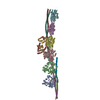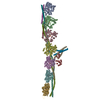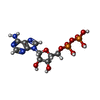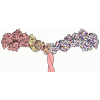[English] 日本語
 Yorodumi
Yorodumi- PDB-9mo9: Structure of native murine cardiac thin filament variant I79N in ... -
+ Open data
Open data
- Basic information
Basic information
| Entry | Database: PDB / ID: 9mo9 | ||||||||||||||||||||||||
|---|---|---|---|---|---|---|---|---|---|---|---|---|---|---|---|---|---|---|---|---|---|---|---|---|---|
| Title | Structure of native murine cardiac thin filament variant I79N in troponin T at pCa=5.8 in Ca2+-free rotated state (lower strand) | ||||||||||||||||||||||||
 Components Components |
| ||||||||||||||||||||||||
 Keywords Keywords | MOTOR PROTEIN / thin filament / cryo-EM / troponin / tropomyosin / muscle structure | ||||||||||||||||||||||||
| Function / homology |  Function and homology information Function and homology informationpositive regulation of heart rate by epinephrine / muscle thin filament tropomyosin / RHOB GTPase cycle / regulation of systemic arterial blood pressure by ischemic conditions / Formation of the dystrophin-glycoprotein complex (DGC) / Striated Muscle Contraction / troponin C binding / cytoplasmic actin-based contraction involved in cell motility / RHOA GTPase cycle / diaphragm contraction ...positive regulation of heart rate by epinephrine / muscle thin filament tropomyosin / RHOB GTPase cycle / regulation of systemic arterial blood pressure by ischemic conditions / Formation of the dystrophin-glycoprotein complex (DGC) / Striated Muscle Contraction / troponin C binding / cytoplasmic actin-based contraction involved in cell motility / RHOA GTPase cycle / diaphragm contraction / regulation of ATP-dependent activity / regulation of muscle filament sliding speed / troponin T binding / cardiac Troponin complex / cardiac myofibril / Smooth Muscle Contraction / actin-myosin filament sliding / cardiac myofibril assembly / regulation of muscle contraction / regulation of smooth muscle contraction / transition between fast and slow fiber / Ion homeostasis / cardiac muscle tissue morphogenesis / actomyosin structure organization / muscle filament sliding / response to metal ion / I band / regulation of cardiac muscle contraction by calcium ion signaling / microfilament motor activity / ventricular cardiac muscle tissue morphogenesis / myosin binding / troponin I binding / myofibril / mesenchyme migration / skeletal muscle thin filament assembly / vasculogenesis / striated muscle contraction / calcium channel inhibitor activity / cardiac muscle contraction / sarcomere / actin filament / filopodium / structural constituent of cytoskeleton / Hydrolases; Acting on acid anhydrides; Acting on acid anhydrides to facilitate cellular and subcellular movement / intracellular calcium ion homeostasis / calcium-dependent protein binding / actin filament binding / actin cytoskeleton / lamellipodium / heart development / cell body / response to ethanol / in utero embryonic development / hydrolase activity / response to xenobiotic stimulus / protein heterodimerization activity / protein domain specific binding / calcium ion binding / synapse / positive regulation of gene expression / protein kinase binding / negative regulation of apoptotic process / glutamatergic synapse / protein homodimerization activity / ATP binding / identical protein binding / cytoplasm Similarity search - Function | ||||||||||||||||||||||||
| Biological species |  | ||||||||||||||||||||||||
| Method | ELECTRON MICROSCOPY / single particle reconstruction / cryo EM / Resolution: 5.6 Å | ||||||||||||||||||||||||
 Authors Authors | Risi, C.M. / Galkin, V.E. | ||||||||||||||||||||||||
| Funding support |  United States, 1items United States, 1items
| ||||||||||||||||||||||||
 Citation Citation |  Journal: J Mol Cell Cardiol / Year: 2025 Journal: J Mol Cell Cardiol / Year: 2025Title: The role of the troponin T interactions with actin in regulation of cardiac thin filament revealed by the troponin T pathogenic variant Ile79Asn. Authors: Cristina M Risi / Maicon Landim-Vieira / Betty Belknap / P Bryant Chase / Jose R Pinto / Vitold E Galkin /  Abstract: Cardiac muscle contraction/relaxation cycle depends on the rising and falling Ca levels in sarcomeres that control the extent of interactions between myosin-based thick and actin-based thin filaments. ...Cardiac muscle contraction/relaxation cycle depends on the rising and falling Ca levels in sarcomeres that control the extent of interactions between myosin-based thick and actin-based thin filaments. Cardiac thin filament (cTF) consists of actin, tropomyosin (Tm) that regulates myosin binding to actin, and troponin complex that governs Tm position upon Ca-binding. Troponin has three subunits - Ca-binding troponin C (TnC), Tm stabilizing troponin T (TnT), and inhibitory troponin I (TnI). TnT N-terminus (TnT1) interactions with actin stabilize the inhibited state of cTF. TnC, TnI, and Tm work in concert to control actomyosin interactions. Cryo-electron microscopy (cryo-EM) provided factual structures of healthy cTF, but structures of cTF carrying missense mutations linked to human cardiomyopathy are unknown. Variant Ile79Asn in human cardiac TnT (TnT-I79N) increases myofilament Ca sensitivity and slows cross-bridge kinetics, leading to severe hypertrophic/restrictive cardiomyopathy. Here, we used TnT-I79N mutation as a tool to examine the role of TnT1 in the complex mechanism of cTF regulation. Comparison of the cryo-EM structures of murine wild type and TnT-I79N native cTFs at systolic Ca levels (pCa = 5.8) demonstrates that TnT-I79N causes 1) dissociation of the TnT1 loop from its actin interface that results in Tm release to a more activated position, 2) reduced interaction of TnI C-terminus with actin-Tm, and 3) increased frequency of Ca-bound regulatory units. Our data indicate that the TnT1 loop is a crucial element of the allosteric regulatory network that couples Tn subunits and Tm to maintain adequate cTF response to physiological Ca levels during a heartbeat. | ||||||||||||||||||||||||
| History |
|
- Structure visualization
Structure visualization
| Structure viewer | Molecule:  Molmil Molmil Jmol/JSmol Jmol/JSmol |
|---|
- Downloads & links
Downloads & links
- Download
Download
| PDBx/mmCIF format |  9mo9.cif.gz 9mo9.cif.gz | 571.3 KB | Display |  PDBx/mmCIF format PDBx/mmCIF format |
|---|---|---|---|---|
| PDB format |  pdb9mo9.ent.gz pdb9mo9.ent.gz | 465.4 KB | Display |  PDB format PDB format |
| PDBx/mmJSON format |  9mo9.json.gz 9mo9.json.gz | Tree view |  PDBx/mmJSON format PDBx/mmJSON format | |
| Others |  Other downloads Other downloads |
-Validation report
| Summary document |  9mo9_validation.pdf.gz 9mo9_validation.pdf.gz | 1.4 MB | Display |  wwPDB validaton report wwPDB validaton report |
|---|---|---|---|---|
| Full document |  9mo9_full_validation.pdf.gz 9mo9_full_validation.pdf.gz | 1.6 MB | Display | |
| Data in XML |  9mo9_validation.xml.gz 9mo9_validation.xml.gz | 108.2 KB | Display | |
| Data in CIF |  9mo9_validation.cif.gz 9mo9_validation.cif.gz | 161.3 KB | Display | |
| Arichive directory |  https://data.pdbj.org/pub/pdb/validation_reports/mo/9mo9 https://data.pdbj.org/pub/pdb/validation_reports/mo/9mo9 ftp://data.pdbj.org/pub/pdb/validation_reports/mo/9mo9 ftp://data.pdbj.org/pub/pdb/validation_reports/mo/9mo9 | HTTPS FTP |
-Related structure data
| Related structure data |  48452MC  9e2eC  9mo4C  9mo5C  9mo6C  9mo7C  9mo8C  9moaC  9mobC  9mocC  9modC  9moiC  9mokC  9molC  9momC  9monC  9mooC  9mopC  9mouC  9mowC  9moxC M: map data used to model this data C: citing same article ( |
|---|---|
| Similar structure data | Similarity search - Function & homology  F&H Search F&H Search |
- Links
Links
- Assembly
Assembly
| Deposited unit | 
|
|---|---|
| 1 |
|
- Components
Components
-Protein , 5 types, 14 molecules ABCDEFGHIJKLMN
| #1: Protein | Mass: 42064.891 Da / Num. of mol.: 6 / Source method: isolated from a natural source / Source: (natural)  References: UniProt: P68033, Hydrolases; Acting on acid anhydrides; Acting on acid anhydrides to facilitate cellular and subcellular movement #2: Protein | | Mass: 18437.520 Da / Num. of mol.: 1 / Source method: isolated from a natural source / Source: (natural)  #3: Protein | | Mass: 24308.908 Da / Num. of mol.: 1 / Source method: isolated from a natural source / Source: (natural)  #4: Protein | Mass: 34660.332 Da / Num. of mol.: 2 / Source method: isolated from a natural source / Source: (natural)  #5: Protein | Mass: 32735.609 Da / Num. of mol.: 4 / Source method: isolated from a natural source / Source: (natural)  |
|---|
-Non-polymers , 2 types, 12 molecules 


| #6: Chemical | ChemComp-ADP / #7: Chemical | ChemComp-MG / |
|---|
-Details
| Has ligand of interest | N |
|---|---|
| Has protein modification | N |
-Experimental details
-Experiment
| Experiment | Method: ELECTRON MICROSCOPY |
|---|---|
| EM experiment | Aggregation state: FILAMENT / 3D reconstruction method: single particle reconstruction |
- Sample preparation
Sample preparation
| Component | Name: Native murine cardiac thin filament variant I79N in troponin T at pCa=5.8 Type: COMPLEX / Entity ID: #1-#5 / Source: NATURAL |
|---|---|
| Molecular weight | Experimental value: NO |
| Source (natural) | Organism:  |
| Buffer solution | pH: 7 |
| Specimen | Embedding applied: NO / Shadowing applied: NO / Staining applied: NO / Vitrification applied: YES |
| Specimen support | Grid material: COPPER / Grid mesh size: 300 divisions/in. / Grid type: EMS Lacey Carbon |
| Vitrification | Cryogen name: ETHANE |
- Electron microscopy imaging
Electron microscopy imaging
| Experimental equipment |  Model: Titan Krios / Image courtesy: FEI Company |
|---|---|
| Microscopy | Model: TFS KRIOS |
| Electron gun | Electron source:  FIELD EMISSION GUN / Accelerating voltage: 300 kV / Illumination mode: FLOOD BEAM FIELD EMISSION GUN / Accelerating voltage: 300 kV / Illumination mode: FLOOD BEAM |
| Electron lens | Mode: BRIGHT FIELD / Nominal defocus max: 3500 nm / Nominal defocus min: 500 nm |
| Specimen holder | Cryogen: NITROGEN / Specimen holder model: FEI TITAN KRIOS AUTOGRID HOLDER |
| Image recording | Electron dose: 34 e/Å2 / Film or detector model: GATAN K3 (6k x 4k) / Num. of real images: 17361 |
- Processing
Processing
| EM software |
| |||||||||||||||||||||||||||||||||||
|---|---|---|---|---|---|---|---|---|---|---|---|---|---|---|---|---|---|---|---|---|---|---|---|---|---|---|---|---|---|---|---|---|---|---|---|---|
| CTF correction | Type: PHASE FLIPPING AND AMPLITUDE CORRECTION | |||||||||||||||||||||||||||||||||||
| Particle selection | Num. of particles selected: 7615631 | |||||||||||||||||||||||||||||||||||
| 3D reconstruction | Resolution: 5.6 Å / Resolution method: FSC 0.143 CUT-OFF / Num. of particles: 39630 / Algorithm: BACK PROJECTION / Details: filtered to 7 Angstroms / Symmetry type: POINT | |||||||||||||||||||||||||||||||||||
| Atomic model building | Protocol: FLEXIBLE FIT / Space: REAL | |||||||||||||||||||||||||||||||||||
| Atomic model building |
|
 Movie
Movie Controller
Controller






















 PDBj
PDBj












